
What does a contaminated oyster mushroom substrate look like and why do stains and mold appear on it?
Substrate overgrowth defects occur for the following reasons:
If the mycelium grows poorly and spots of non-growth form, do not rush to blame the grain spawn seller.
Uneven fouling of mushroom blocks is possible for many reasons.
For example, low temperature in the incubator (14-17 degrees) affects the rate of hyphae germination in the substrate mass. While the hyphae slowly grow, bacteria, which are quite comfortable at this temperature, actively multiply in the space between the film and the substrate, where moisture collects. Because of this, dark areas appear in the block.
Read how to properly incubate.
Or, you have incorrectly heat-treated raw materials.
Can mycelium beat contamination?
Since we introduce a large amount of grain spawn, the mycelium quickly takes over the substrate.
It inhibits the growth of many microorganisms, including through the release of various organic acids and other biologically active components. However, we do not even see this process, since if the mycelium is stronger than competitors, we do not see their development.
If the mycelium loses the fight against contamination, we see spots of mold or bacteria between the film and the substrate. Most often, there are lesions in the thickness of the bags too.
Consider the main types of contamination and how to eliminate them.
Table of Contents
Yellow mass in the perforation of an oyster mushroom block - slime mold
Stains may indicate that the oyster mushroom block is infected with bacteria or mold. However, there are also spots of other types.
Spots are of three types:
- white,
- yellow or orange,
- dark.
They are isolated roundness, formed in the early stages of incubation and are clearly visible against a dark background of not yet overgrown husks. Sometimes noticeable even on the second or third day of incubation.
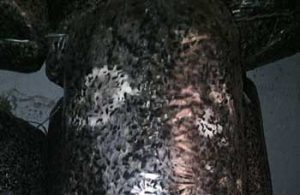
Such spots are formed around the caryopsis with mycelium. Most likely, these are hyphae of oyster mushroom mycelium, which has grown like a cobweb. Why some gifs behave this way, I cannot explain.
But, I know for sure - this does not characterize the grain spawn in any way - either for good or for bad.
If the raw material is processed with high quality, these spots do not affect the overgrowth process.
On the 6-7th day of incubation, when all the husks or straw turn white, they intertwine with the rest of the hyphae and do not stand out. The yield of the batch also does not depend on whether there were such spots at the beginning of overgrowth or not.
Such spots are not at all like stroma, a dense white crust, which is described here.
Typically, yellow spots in the substrate are wetter than the rest of the substrate. Sometimes they are jelly-like, sometimes more watery.
Yellow liquid in mushroom grow bag
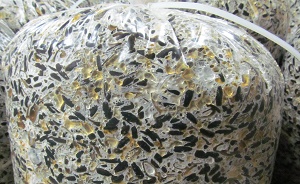 Sometimes under the film we see small spots of yellow, redheads or brown liquid.
Sometimes under the film we see small spots of yellow, redheads or brown liquid.
If these spots are almost transparent and have a pleasant smell, then the color appears due to staining with pigments from husks, straw or hay.
They are not dangerous and often disappear during fruiting.
It happens that these droplets flow down, and in the corners of the bag we see brown and yellow liquid.
I read recommendations to cut off these corners to allow the liquid to drain. If you do this, place some small container so that this liquid does not flow onto the floor.
Most likely, this is just excess water, colored by the pigments of the raw materials, but it is quite possible that bacteria have already begun to multiply in it. Therefore, it will be better not to let the liquid get on the floor.
By the way, I want to say one more thing about mycelium metabolites. In the English-speaking mushroom growing community I heard the expression “mushroom urine”. They don't say that here, so I was surprised.
If in this situation the block is white and well overgrown, this water does not harm the substrate.
But more often there are orange or yellow spots of non-growth on oyster mushroom blocks that are affected by bacteria.
If we cut the film in the place of such a yellow spot, we will see that it is water slime. That is, the water does not flow, but is more like liquid jelly.
Such packages have an unpleasant smell - sour, less often alcohol or ammonia. Such a spot looks like a yellow gelatinous formation or like a dark piece of straw or husk.
This is a sign of waterlogged substrate.
On a waterlogged substrate, yellow oyster mushrooms grow, often with a curly or wavy hat.
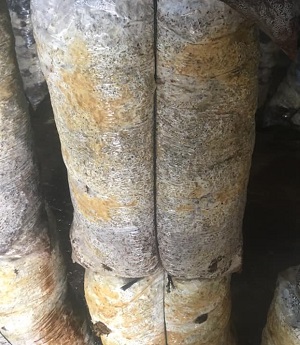
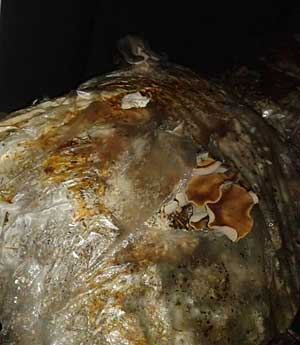
If the substrate is too wet, the primordia will turn brown and sticky. If you squeeze them with your hand, drops of water appear.
The second reason why the mushroom block often turns yellow is an attempt to cool the blocks sharply during incubation.
If in this case green spots of mold do not form, then we see yellow spots where mycelium does not grow.
To avoid the formation of yellow spots, you need to make a substrate of optimal humidity (68-69%) and observe the microclimate parameters in the incubator. More about it.
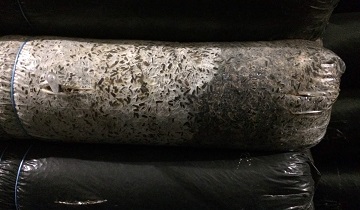 As the bag grows, a clear boundary is formed between the white hyphae of the mycelium and the compost.
As the bag grows, a clear boundary is formed between the white hyphae of the mycelium and the compost.
Or it happens that the colonization of the substrate (compost) by mycelium proceeds normally, it turns white, and then stops growing and darkens.
What prevents oyster mushroom mycelium from developing freely in the territory of the dark spot? Microorganisms to which the conditions in the spots are more suitable.
Such areas appear due to one of four reasons, or a combination of them:
Sometimes small larvae appear under the polyethylene in the area of the dark spot (see photo here). It was they who ate the mycelium. Infected bags must be immediately removed away from the growing chamber, and the incubator should be treated with insecticides.
Don't forget about protective equipment!
This is the most common type of defect (flaw).
This most often occurs during heat treatment of raw materials with hot water (hydrothermal method) and improper xerothermy (when dry raw materials are treated with steam).
Mold or mycelium
It is difficult to distinguish oyster mushroom mycelium from mold in the early stages of growth, as most molds have the same white hyphae.
In fact, the hyphae of the green Trichoderma mold, which most often affects the substrate, are of an unsaturated whitish color, even with a light gray tint. And the hyphae of oyster mushroom mycelium are pure white, although their color is also not very dense.
However, distinguishing these colors from one another is a very difficult task.
And only mold spores of different colors. It takes from 3 to 7 days for the spores to mature, and then you can see whose mycelium it is.
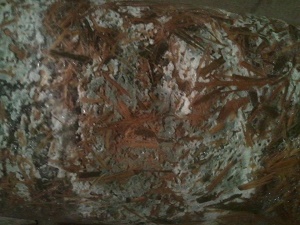 Most often, various types of trichoderma settle in the overgrown substrate, its spores are green in color: from olive to gray-green.
Most often, various types of trichoderma settle in the overgrown substrate, its spores are green in color: from olive to gray-green.
If the mold speck is small, then the oyster mushroom hyphae suppress its growth, and fruiting proceeds normally in the future.
Large spots of green mold on mushroom substrate, on the contrary, progress and inhibit the development of oyster mushrooms.
Many people are surprised that the mushroom block turned green on the 12th or even 15th day, and before that it was white.
In fact, the mold was in the raw materials from the very beginning.
But it was not visible, since the trichoderma hyphae are white, with a grayish tint. And when the mycelium of Trichoderma matured, we saw green clusters of its spores.
Since green mold annoys mushroom growers most often, I wrote a separate article about it with recommendations for combating various types of mold.
Black mold reproduces much less frequently than green mold. Most often, these are various types of mucor. But, you don't have to know exactly what type of black mold is in the block.
You can get rid of it in the same way as green mold ↑
As a rule, black mold develops on poor quality raw materials. If rain falls on the straw or husk during storage, its moisture content rises. Mold spores germinate and multiply.
Sometimes there are so many of them that standard heat treatment of raw materials cannot kill a significant part of these spores. Even if you increase the temperature and processing time, it will not help.
The best option is to buy dry, clean raw materials and store them in a dry place.
Below I describe another type of black mold, popularly called "black hair"
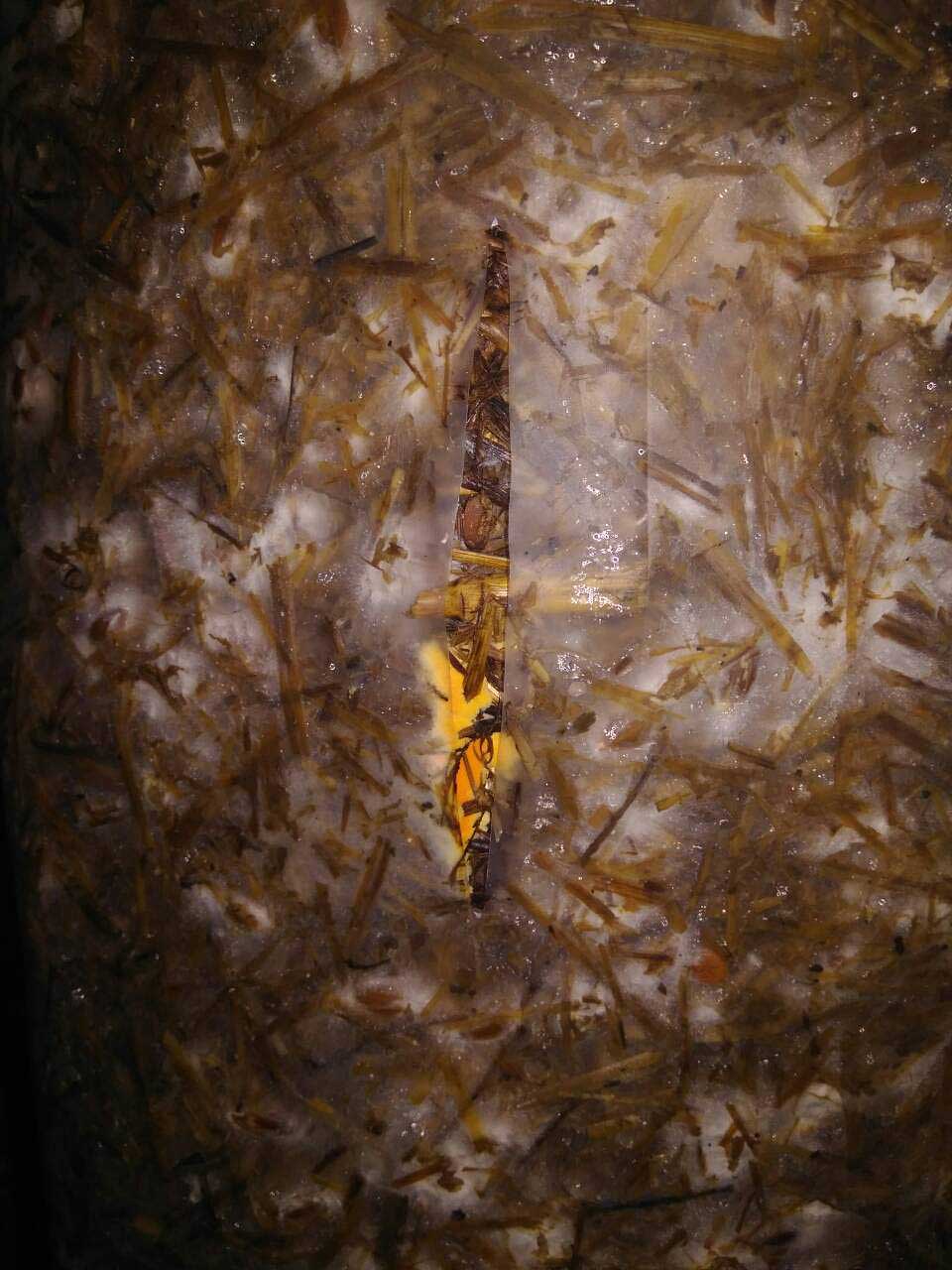
This mold needs to be distinguished from Slime mold - this is the organism that I will talk about next.
If you find an orange substance in a bag, especially if it goes into a slot, seal the perforation with tape and take this block away from the enterprise.
Release it from the film, bury it, and burn the polyethylene. Be sure to treat the room with chemicals such as Armex, Virocid.
If there are already overgrown batches in it, take them out to the growing chamber.
You may not want to carry freshly made blocks during the disinfection, but try not to get the drug on them.
Neurospora reproduces very quickly, it can infect the entire incubator in a matter of days.
Do not wait until the incubator is free - you risk losing everything that is there.
Neurospora is a soil fungus.
Infection of sunflower husks occurs if the stubble of cereal plants was burned on the field before sunflower sowing, spores also get into the straw.
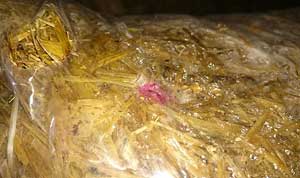
Neurospore is a rather rare type of mold for mushroom growers - it is also called "red bread mold".
Its spores are orange-red or pinkish in color.
But if the spot is pure pink, it is probably another fungus, from the genus Fusarium. It infects the stalks of cereal crops, and more often appears in the straw raw materials with insufficient heat treatment.
With hydrothermia, it appears if the straw is not soaked, but immediately poured with hot water.
On many old farms and poultry houses, even if the buildings have been abandoned for many years, specific pathogenic microflora persists. Most often, spores of various mold fungi.
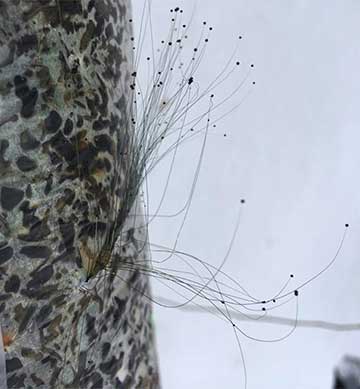
Among them is the species of mucoraceae - Spinellus fusiger. This mold appears in a slot and looks like long black threads with black sporangia balls.
What do we have to do?
More photos and a detailed story about different types of mold in my video.
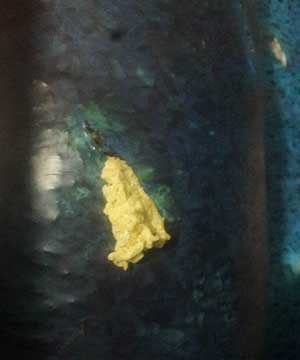 Sometimes when growing oyster mushrooms, you can meet living creatures of Myxogastria. They look a little like both mold and fungus. You can read about them on Wikipedia, the article is called "Slime mold".
Sometimes when growing oyster mushrooms, you can meet living creatures of Myxogastria. They look a little like both mold and fungus. You can read about them on Wikipedia, the article is called "Slime mold".
Most often they settle in greenhouses and in adjacent territories. When dry, it resembles withered polyurethane foam. When there is a lot of moisture in the air, it looks like yellow mold or grows in a slimy clot.
This yellow slime has pseudopods that travel through the growing chamber at a speed of 1 to 2 centimeters per hour.
Slime mold is almost never found in the incubator. But the mushroom growers who sent this photo saw it in the slot of the overgrown block.
In this case, a complete disinfection of the room is necessary.
If it is impossible to take out all the blocks from the incubator, it is necessary to disinfect the walls, floor, empty racks, trying not to get on the perforations in the blocks. The room is disinfected with an antifungal drug or hydrogen peroxide 5%, or a solution of any drug containing peracetic acid.
